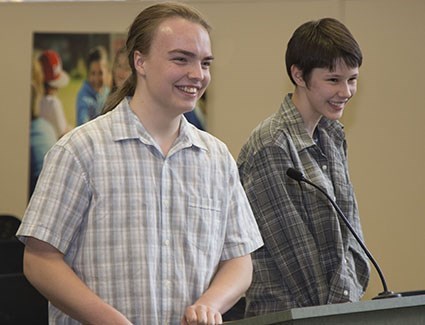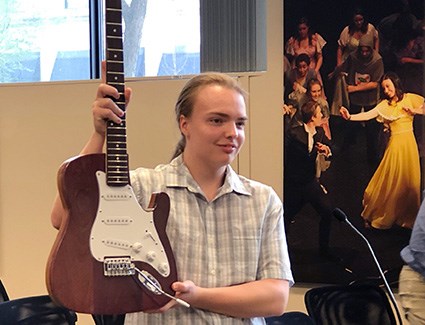 When Leif Pederson plays his guitar, every note that emerges is a product of not only his ability as a musician but also his skill in design, woodworking and electronics.
When Leif Pederson plays his guitar, every note that emerges is a product of not only his ability as a musician but also his skill in design, woodworking and electronics.
Pederson's guitar is the finished product from Guitar & Amplifier Design and Construction 30, a class unique to Bedford Road Collegiate and one of the wide range of Practical and Applied Arts (PAA) courses offered to students attending Saskatoon Public Schools collegiates.
"One of the greatest joys any teacher experiences is seeing their students connect and find passion in their particular subject area," says Brad Peterson, a woodworking and drafting teacher at Bedford Road.
"We have a very vibrant practical course program with classes in cooking, drafting, sewing, photography, work education and woodworking — among others — that are every bit as important to our students as any course. We also have the pre-engineering program where students experience the hands-on side of engineering design and practices."
For Leif Pederson, the experience of learning and the applying his skills to create an electric guitar from scratch was a challenge as both a student and a musician. With a morning timetable comprised of core academic classes, the opportunity to engage in hands-on learning during the afternoon provided a welcome balance to his school day.
 "The electric guitar is a very good incentive for students like me to join a course, but this class offers so much more than that," he said. "We also learn practical skills, like 3D drawing in SolidWorks. We get to hone our skills in carpentry and woodworking as well as our knowledge in electronics as we build a portable amplifier along with the guitar.
"The electric guitar is a very good incentive for students like me to join a course, but this class offers so much more than that," he said. "We also learn practical skills, like 3D drawing in SolidWorks. We get to hone our skills in carpentry and woodworking as well as our knowledge in electronics as we build a portable amplifier along with the guitar.
"And, for the musicians like me in the class, we get total knowledge of the instrument we know and love."
Each collegiate offers a core program of PAA courses such as career education, information processing, woodworking and carpentry, food studies, drafting and photography. Programs such as mechanics, welding, machining, construction, electronics, animation and others are options for students attending specific schools.
When they enter high school, Grade 9 students enroll in a PAA survey course of their choice that exposes them to a variety of opportunities. Beginning in Grade 10, students can choose from a number of PAA electives that focus on specific areas of study and complement the core of required courses.
For Sophie Fraser Markan, the decision to enroll in Drafting 10 was initially daunting.
"Working with computers and measurement has never really been my forte, but if I wanted to go on to urban design I was going to give it a shot," she said. "Apparently, it's not that scary and I enjoyed it immensely. As well as being an amazing class over all, it has given me the resources to figure out what I am going to do with my life."
She says the class was an eye-opening experience in terms of both understanding the basics of design and coming to the realization that she was able to rise to the challenge and succeed in her learning.
"It was getting to know things, like the computer program we use, AutoCAD. I had never done something like that. I had always thought of myself as someone who wasn't good at it, so it was kind of getting over that, which was a confidence boost. Getting the feedback when it's positive, finding out what you can do better and working on that really helps a lot."
Peterson believes the opportunities offered by PAA courses provide students with skills and understanding that will be useful throughout their lives, no matter what direction their careers take.
"PAA course are a hands-on application of reading and writing to follow instructions for understanding, of measuring, planning and organizing materials and time and many other practical skills. Hopefully these experiences also help students to begin to find and grow their passion and provide direction for their future," he said.
"Our projects are puzzles. You look at the whole and it can be very daunting, but individually it is just a group of pieces. If students can be successful on one particular piece and then be successful on another piece and then bring those things together, the end result is something that they are very proud of — it gives them a great sense of joy. I think most people understand that doing those things that we often (otherwise) don't get to do means a change of mindset, a change of thinking."